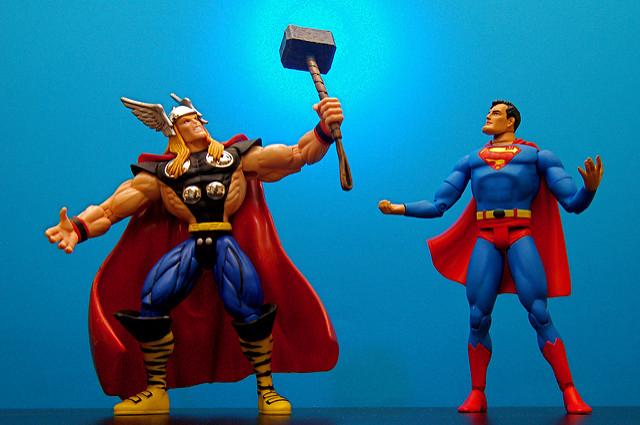Eight years after “Iron Man” set the stage — and perfected Marvel’s new brand — Disney’s unprecedented superhero franchise is still running like clockwork.
Disney released the 13th entry in its hugely popular canon, “Captain America: Civil War,” last Friday to universal praise and a staggering opening weekend haul for a non-Avengers picture. This movie positions viewers at the beginning of Phase Three of the Marvel Cinematic Universe.
Phase One ranged from the first Iron Man film and ended with “The Avengers,” which was followed by the second stretch bookended by “Iron Man 3” and “Ant-Man.” Phase Three is presumably Disney’s last while the company makes plans beyond this decade.
Meanwhile, Warner Bros., who owns DC Entertainment and DC Comics, is tripping over itself in an overt attempt to imitate Marvel’s success in the crowded genre.
The studio is scrambling to craft a Justice League movie, and since it’s already made so many missteps in its short existence, DC’s future popularity and profitability looks far less certain than Marvel’s.
In general, superhero fatigue — a branch of blockbuster fatigue — affects studios across the board. The oversaturation of the superhero genre, especially Marvel’s output alone, has been clouding the enjoyment of individual movies since before “Avengers: Age of Ultron.”
But Disney’s skill at pushing mechanically designed, fast moving comic-book-movie thrills seems second-nature. This is due in part to the comparison with DC’s pathetic attempt at an interconnected franchise of its own.
DC gave us “Batman v Superman: Dawn of Justice” — the second in the company’s own iteration of a collective filmic universe for its comic book heroes — a little over a month ago. The film was subject to critical panning and underwhelming box office results considering the popularity of the iconic characters involved.
Despite a $250 million budget, DC’s first attempt to showcase multiple heroes in a single film is still struggling to near the billion dollar mark in worldwide gross, which would be a moderate feat for a blockbuster with such widespread appeal.
It’s likely that the disappointments are going to continue.
Zack Snyder, the infamously indulgent director behind the new DC franchise’s first two films, is known for his visually dynamic yet intellectually hollow filmography — see “300” or “Sucker Punch.” Even though his two superhero films have set a sour tone for this series, he is on board to direct the rushed two-part Justice League movies, the first of which is out next November.
While audiences may have been getting tired of the sameness in Marvel’s recent filmography, the bloated mess of “Batman v Superman” provided the necessary contrast to see how right Marvel had been doing it all along. So far, DC’s flukes have only strengthened Marvel’s brand.
Marvel’s gambles are now big-time contenders — after the success of the original, the sequel to “Guardians of the Galaxy” is slotted for the coveted first weekend of May 2017, the same weekend all “Iron Man” and “Avengers” films debuted. The characters Marvel digs up get progressively more obscure, but they’re the basis for the films that surprise us most — this year’s “Doctor Strange” has such potential.
Marvel’s capacity to put considerable money into risky projects like “Ant-Man” just continues to fuel the cycle of profit and keep its vast universe thriving.
Save for Superman, DC is forgoing stand-alone films, like Marvel’s “Iron Man” and “Thor,” in order to build interest towards major events like Marvel’s “The Avengers.”
Marvel has slated 10 new films between “Civil War” and the supposedly final Avengers in summer 2019 — four more films than Phase One or Two. This means that if DC wants to compete with Marvel’s monopoly on the genre, it has no choice but to continue the trend of profitability over creative purpose.
“Justice League: Part One” will arrive before the Flash, Aquaman and Cyborg have solo films, and Ben Affleck’s Batman film has yet to set a release date.
With “Batman v Superman,” DC proved that its goal is to introduce well-known superhero characters and have them fight each other as quickly as possible.
Not that Marvel is infallible, or DC’s franchise is beyond saving. Most of “Civil War” is also an excuse to watch super-powered people beat each other in colorful ways, showing that there’s little surprise left for viewers absorbing yet another chapter of the expanded story.
But the movie earns its thrills because of Marvel’s carefully weaved overarching narrative behind each film. When character development and the gradual construction of stakes are abandoned, you get the vapid excess of DC’s “Batman v Superman.”
DC’s “Suicide Squad” — due to release this August — and next year’s “Wonder Woman” may offer an improvement to the company’s Extended Universe. They’re both free of Snyder’s toxic touch and have more potential than the recycled excitement of rebooting Batman and Superman, which has been done twice now for each character.
While each Marvel film may lay out a convoluted narrative, make too many excuses for combat and confrontation and juggle a plethora of characters — “Civil War” is as culpable as any of them — there are still moments of humanity and humor via well-established characters that keep the superhero world real. DC has no time for such luxuries.
Though the concept of superhero movie universes screams money-grubbing Hollywood, it is only DC’s corner that seems truly steeped in cynicism. Marvel can afford to find the joy in each passing film because it already has its future worked out.



